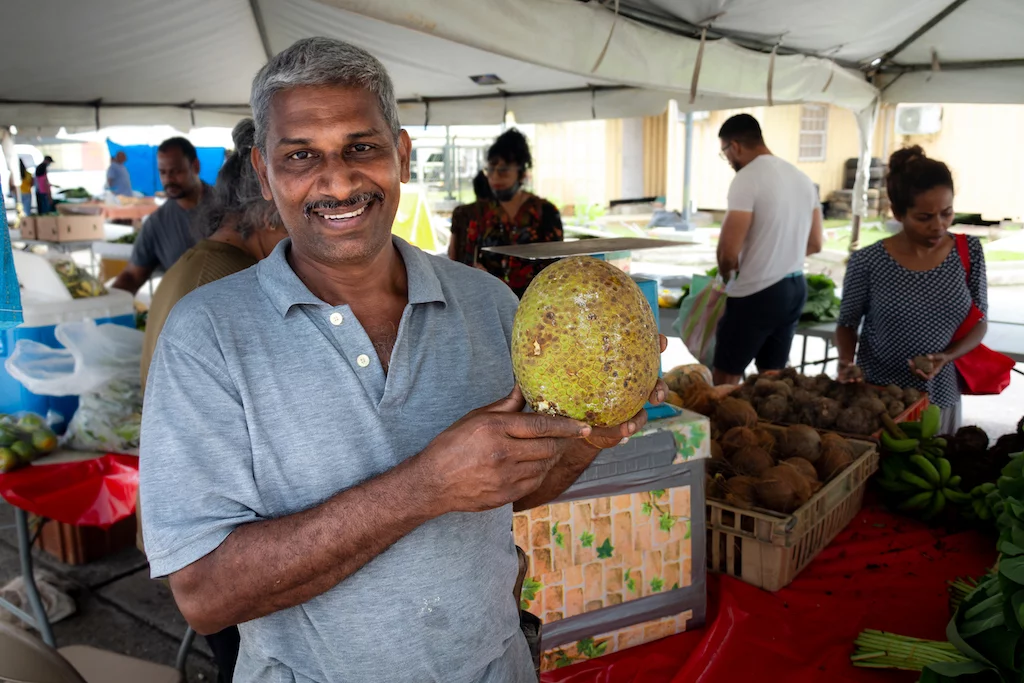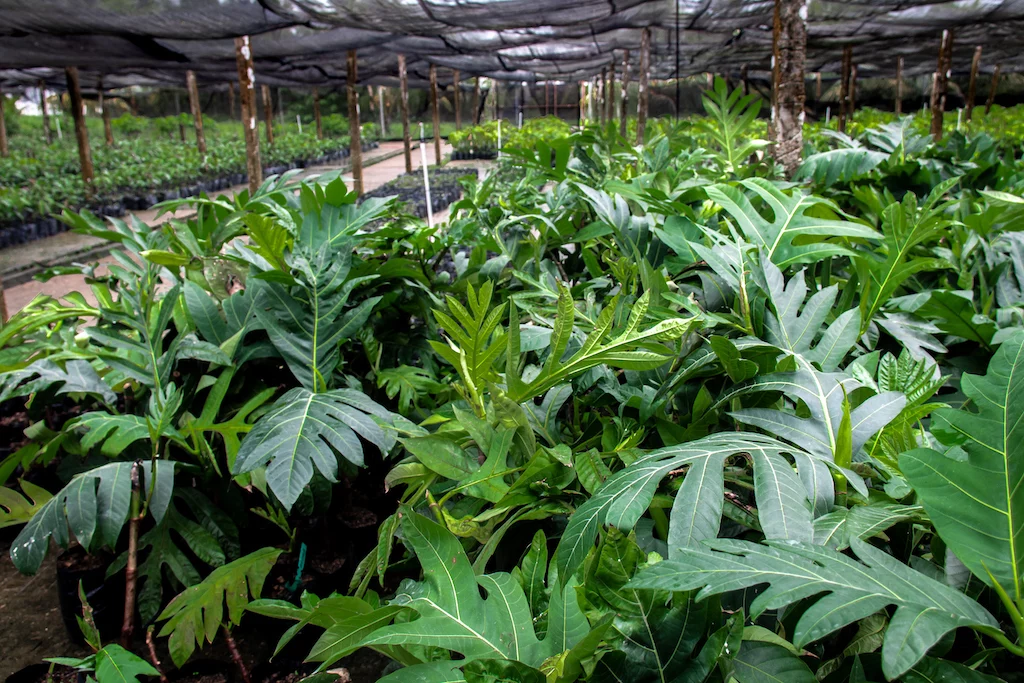
A breadfruit growing on a tree.
Despite its colonial origins, breadfruit is now the subject of international research to evaluate its potential as a staple crop in a warming world.
BY JADE PRÉVOST-MANUEL
JAN 2, 2023
It’s early on a Saturday morning, but already, the scorching November sun—a rarity following five months of unusually torrential rains—has thinned the crowd at Trinidad’s Chaguanas farmers market. Here, local farmer Wayne Ramrattam sells his produce. Customers reach for the coconuts, dasheen, plums, and mangoes in his stall. But it’s the breadfruit, the farmer says, that Trinbagonians really can’t get enough of. This soccer ball-sized fruit has a bumpy green exterior and a potato-like interior that makes it incredibly versatile.
“It’s a fruit that people love,” he says, and the single breadfruit left at his table is a testament to its popularity. “Anything you does make with it, it taste good. If I bring 200 breadfruit here, it sell out and people still coming for it.”
Lucky for Ramrattam, his farm has had no shortage of the fruit this year. The 20-or-so trees on his property can produce as many as 4,000 breadfruits in a single year.

Breadfruit was brought to the West Indies from Tahiti at the turn of the 18th century as a cheap, filling, and abundant food for enslaved people. This starchy round edible, as a result, has grown prolifically in Trinidad and Tobago for hundreds of years.
Breadfruit is a perennial crop; one tree can produce fruits every year for half a century or more. The trees naturally produce as many as 300 fruits per year, without the application of chemical or synthetic fertilizers, according to Omardath Maharaj, a lecturer in agribusiness and entrepreneurship at the University of the West Indies. Plus the fruit is a good source of carbohydrates, dietary fiber, and potassium.
Today, breadfruit is a staple in Caribbean cuisine. Its association with the sinister history of slavery, for many, is no longer its defining quality. The fruit is now the subject of international research to evaluate its potential as a staple crop in a warming world. In Trinidad and Tobago, climate change, inflation, and dependence on imports are drivers of its national food insecurity, which affected nearly half of the population last year. On average, the country imports as much as 85% of its food.
Locals say breadfruit is a key crop for filling hungry bellies. It’s hearty, easy to grow, and locally abundant.
One breadfruit can feed as many as four people for dinner. It can be sliced thin, fried, and seasoned with garlic and salt to produce chips. It can be skinned, chopped, and boiled in a mixture of dasheen bush leaves, coconut milk, and pig tails to make a salty stew called oildown. Or, it can be baked into a belt-busting pie.
“[Breadfruit] does stretch real far,” Ramrattam says. “Just two, three pieces, and your belly full.”
A Food for Future Climates
Small Island Developing States like Trinidad and Tobago are expected to feel the brunt of climate change’s effects, such as rising sea levels, tropical storms, drought, and changes in rainfall. These could negatively impact crop yields, destabilizing already precarious food systems. Compared to existing commodity crops like rice, corn, and soybeans, experts suggest that breadfruit’s resilience and prolificacy could help create more sustainable food systems and ease global food insecurity.
In a paper published in PLOS Climate in August, scientists modeled how different climate futures could impact breadfruit yields around the world. Under the highest emission scenario, they predicted that climate change-driven changes in rainfall and temperature could reduce the overall quality of suitable breadfruit-growing areas on Caribbean islands. The loss of suitable growing areas, however, amounted to less than 2%—arguably good odds under dire circumstances.
It’s worth noting that studies examining how climate change could impact breadfruit-growing in Trinidad and Tobago specifically have yet to be carried out. But the tree’s life history makes it a strong candidate for sustaining Trinbagonians in the long run compared to annual crops like wheat and rice.
Research and history have proven that these trees can take a beating. Breadfruit can withstand drought for up to four months. When Hurricane Maria devastated Puerto Rico in 2017, breadfruit trees were among the few trees left standing. And while the persistent rains of Trinidad’s 2022 rainy season destroyed scores of crop fields across the country, it brought good fortune to breadfruit growers like Ramrattam, who saw his trees thrive in wet conditions.
“[In my opinion], in stress situations, in times of a disaster, in times of rising cost of living and all these other challenges, there’s no other competitor,” Maharaj says. “And the fact is, breadfruit has withstood the test of time, whether it be climate change or westernization of the Caribbean diet.”
Long-lived breadfruit trees can feed families for generations. At maturity, these trees also sequester more carbon than young trees, making them carbon sinks. Getting young trees to catch can be tricky, but once they’re established, maintaining them is a relatively hands-off process requiring no chemical inputs.
Despite all this, breadfruit production is considered underdeveloped in Trinidad and Tobago. Local breadfruit varieties are blended into species-rich food forests where they provide the necessary shade for crops like cocoa. The breadfruit trees on Ramrattam’s property are interspersed with the plums, cherries, mangoes, and other foods he grows.
Rarely is breadfruit produced on a commercial scale or processed to produce long-lived food items like flour—though doing so could provide Trinidad and Tobago with a greater supply of food for tough times as well as export income.
Some Assurance in an Uncertain Future
In the face of rising food prices, Maharaj says planting trees empowers citizens to feed themselves. That’s why he and his colleague Raul Bermudez started Breadfruittrees.com, an NGO working to get more breadfruit trees in the backyards of Trinbagonians. Over the years, the team says it has donated thousands of young breadfruit trees to individuals, schools, communities, and prisons.
Maharaj sees the trees as assets—ways of ensuring intergenerational wealth “for those of us without financial investment resources.”
By that definition, investing in breadfruit is fairly cheap and generally yields a high return on investment. In Trinidad and Tobago, you can pick up a tree for around $3.50 USD, or $2.30 if you’re buying in bulk, says Fareed Ali, agricultural assistant at La Reunion Plant Propagation Station. He and his colleagues produce some 10,000 baby breadfruit trees each year. Subsidized by the government, these saplings are available for purchase by farmers, private citizens, and the folks at Breadfruittrees.com who get them into the backyards of hungry people. According to Ali, the trees they sell typically begin to bear fruit in just three years.

“The price of breadfruit and fresh food has kind of skyrocketed,” Ali says, “so people who love breadfruit would want to plant at least one tree in their backyard so that they themselves can supply their household.”
Breadfruit trees can bear fruit as many as four times a year, Ramrattam says, depending on temperature and rainfall. During drier, hotter years, the fruit tends to drop early, meaning he has fewer, smaller, and less tasty breadfruits—young fruit can be bitter—to sell at market. Things are good this year at the farmer’s property in Manzanilla, where he says heavy rains have given him bigger and better breadfruit. He expects the harvests will continue to be good in the coming years.
“I’m not worried for me; I’m not worried for my wife,” says the farmer, weighing a bundle of dasheen for a customer as the market’s vendors close up shop. “I’m worried for the kids…for them, we don’t know how it will be.”
With climate change, Ramrattam expects food security to be an increasing problem in the next 20 years.
As Trinidad and Tobago prepares for an uncertain climate future, Maharaj says sustainable food sources like breadfruit should be an integral part of the Caribbean country’s food security contingency planning.
“I think that it’s time we recognize the versatility and contribution that foods like these could lend to our sustainability,” he says. A breadfruit tree can “more than likely feed us for the rest of our lives.”
JADE PRÉVOST-MANUEL is a Canadian multimedia journalist, writer and copy editor currently based out of Trinidad and Tobago. A former CBC News associate producer, she worked in investigative journalism and daily news at both the local and national levels. In 2021, she broke a story about the discovery of a new species of ocean sunfish in Canadian waters and interviewed Olympic champion Maggie MacNeil on the heels of her Tokyo 2020 win. Her stories have appeared in publications like enRoute, Canadian Geographic, ON Nature, Outpost, and CBC Sports. She’s a former recipient of the Canadian Broadcasting Corporation’s Joan Donaldson News Scholarship and a registered member of Editors Canada. She is also a proud alumnus of both McGill University and Western University. When she’s not telling stories on land, you can find her exploring life below the ocean’s surface. |
No comments:
Post a Comment